[Recent Entries][Archive][Friends][User Info]
Below are the 20 most recent journal entries recorded in the "Сообщество, посвящённое ра" journal:| September 19th, 2011 | |
|---|---|
| 08:03 pm [industrialterro] [Link] |
Thelodus Thelodus is an extinct genus of primitive jawless fish that lived in the Silurian period. Fossils have been found worldwide. Thelodus belonged to the Thelodonti, a group of jawless fish lacking the armored plating characteristic of the related Heterostraci. The position of Thelodus`s mouth suggests that it fed on the ocean floor. Despite this lifestyle it was also a good swimmer, as indicated by its elongated lower caudal lobe and stabilizing dorsal fin, anal fin and paired pectoral fins.
Tags: Вымершие бесчелюстные, Силур |
| September 15th, 2011 | |
| 08:19 pm [industrialterro] [Link] |
Немного силурийской ботвы К концу силурийского периода началось освоение суши растениями. В начале девона болотистые прибрежные суши были уже густо заселены примитивной низкорослой флорой, образованной различными вымершими группами тайнобрачных, главным образом псилофитами и примитивными сосудистыми растениями - птеридофитами. Эти растения размножались спорами, переносимыми ветром. Побеги примитивных наземных растений вырастали из клубневидных или стелющихся несущих корни образований; они ветвились и несли на вершины спорангии. Наиболее примитивные псилофиты не имели листьев (Rhynia, Horneophyton (прим. - на данном этапе выделены в отдельный класс риниофитов (Rhyniophyta))), у других побеги были покрыты зачаточными листьями (Psilophyton). На рисунке изображены типичные виды псилофитовой флоры нижнего девона. Справа над поверхностью воды поднимает свои пучки низкий и мелкий Zosterophyllum (промежуточная форма между папоротниками и плаунами); слева от него, на суше, возвышается высокий Psilophyton, под ним стелется звёздчатый Sciadophyton, наконец, слева у воды тянется вверх Protolepidodendron, предшественник современных плаунов. Вдали раскинулись заросли ползучих дрепанофикусов (Drepanophycus), внешне сильно напоминающих плауны. Спорангии у дрепанофикуса и протолепидодендрона на ветвях, несущих маленькие листочки. В листья уже проникла сосудистая система.
Cooksonia, древнейшее сосудистое растение, средний силур
Tags: Растительность, Силур |
| September 14th, 2011 | |
| 08:44 pm [industrialterro] [Link] |
Psarolepis Psarolepis (pronounced /sæˈrɒlɨpɨs/, psārolepis, from Greek ψαρός 'speckled' and λεπίς 'scale') is a genus of extinct lobe-finned fish which lived around 397 to 418 million years ago (Pridoli to Lochkovian stages). Fossils of Psarolepis have been found mainly in South China and described by paleontologist Xiaobo Yu in 1998. It is not known certainly in which group Psarolepis belongs, but paleontologists agree that it probably is a basal genus and seems to be close to the common ancestor of lobe-finned and ray-finned fishes. In 2001, paleontologist John A. Long compared Psarolepis with Onychodontiform fishes and refer to their relationships. Psarolepis had a pair of 'parasymphysical tooth whorls', teeth which extend up at the front of the lower jaw. The head was made of several thick dermal plates and covered with deep pock-marks and large pores. Another trait is a large pectoral spine, just in front of the pectoral fin, extending back from the shoulder girdle, and a dorsal spine located in front of a median fin behind the head, which gives the fish a shark-like form. The pock-marked head of Psarolepis was made of plates containing a layer of porcelain-like cosmine. Because the cosmine layer obscures the suture lines of the skull, it is difficult to study the exact bone structure. The snout was strangely humped and the nostrils were located above the eyes, which were just above the upper jaw. The most spectacular findings were the fin spines. Two are known: one extending back from the shoulder girdle and another which is associated with the dorsal fin. These fin spines are found only in primitive jawed fishes and are apparently absent from the most primitive sharks, but present in abundance in more derived forms. Psarolepis had teeth at the very front of the snout with large fangs on the tooth plate. Outstanding feature are the 'parasymphysical tooth whorls' which place the fish in the order of onychodontida. The premaxilla and the dentary had large inner teeth and irregular array of tiny outer teeth. When Psarolepis was described for the first time in 1998, it was placed in the group of sarcopterygians (lobe-finned fishes) because the skull and jaws resemble those of primitive lungfishes. In 1999 Zhu et al. were unable to locate Psarolepis in the cladogram because they did not know if it was the most primitive lobed-finned fish or the most primitive bony fish. There are some characteristics that bony fish do not have, such as the median spine located behind the head, which is known in sharks and acanthodians, and the pectoral spine extending back from the shoulder girdle which is found in some placoderms and acanthodians. Later, in 2001, Zhu and Schultze gave more basis to the theory that Psarolepis was probably a basal bony fish. The same year Long re-examined the phylogenetic position of the fish and pointed out several similarities between Psarolepis and Onychodontiform fishes. He also noted that the presence of a rotational tooth whorl combined with the other characteristics in the skull, and possibly in the shoulder girdle, show that Psarolepis is better placed as a sister taxon to Onychodus as the most basal member of the group of Onychodontiforms. Moreover, Long, referring to new fossils collected from Gogo Formation, Western Australia, said that Psarolepis and Onychodus are both basal bony fish and are more primitive than other lobe-finned groups.
Tags: Вымершие рыбы, Лопастепёрые, Силур |
| 08:29 pm [industrialterro] [Link] |
Guiyu oneiros Guiyu is an extinct genus of bony fish, and is the earliest known one. It lived during the Late Silurian (419 million years ago) in China. It has the combination of both actinopterygian and sarcopterygian features, although analysis of the totality of its features place it closer to Sarcopterygii.
Tags: Вымершие рыбы, Лопастепёрые, Силур |
| 08:09 pm [industrialterro] [Link] |
Акантоды В силуре появляются первые настоящие костные рыбы. Аканто́ды, или колючкозу́бые (лат. Acanthodii, раньше — Acanthodei) — класс вымерших рыб, имевших по-видимому черты присущие обоим подклассам костных рыб — и лопастеперых, и лучепёрых рыб. Существовали с позднего силура (430 млн лет назад) до ранней перми (250 млн лет назад), главным образом в пресных водоёмах. Питание — предположительно, планктон. Древнейший из известных акантод был морским животным, но на протяжении девона пресноводных становилось всё больше. У них замечены две особенности не обнаруженные у более ранних видов позвоночных: у них была челюсть, и они имели достаточно крепкий позвоночник, что помогало им в плаванье, так как их спинной плавник был более закреплённым нежели у акул. Акантоды делятся на три отряда: климатиеобразные, ишнакантообразные и акантодообразные. Климатиеобразные имели много маленьких защитных костей на позвоночнике, у ишнакантообразные на челюсти имелись зубы, в то время, как акантодообразные зубов не имели, но зато у них были длинные жаберные гребни. На первый взгляд акантоды напоминают современных костных рыб, за исключением таких признаков, как заметно гетероцеркальный хвостовой плавник и прочные шипы, поддерживающие все прочие плавники. Хотя небноквадратный элемент сходен с имеющимся у хрящевых и типичных костных рыб, гистология зубов здесь иная (отсутствует эмалеподобный слой), а свидетельств их регулярной смены нет. Этот признак весьма существен для установления родственных связей акантод, поскольку способ смены зубов важен для отделения хрящевых и основных групп костных рыб от плакодерм. Акантод, по-видимому, следует признать самостоятельным классом, стоящим особняком и от хрящевых, и от костных рыб, однако их сходство с последними делает более удобным обсуждение этой группы вместе с настоящими костными рыбами. Обзор акантод недавно проведен Денисоном (Denison, 1979); важные работы по ним публиковались и раньше (Miles, 1965, 1968, 1973а, Ь; Jarvik, 1977;0rvig, 1973; Watson, 1937). Акантоды-это первые челюстноротые, появляющиеся в палеонтологической летописи. Они представлены чешуями, зубами и плавниковыми шипами в прибрежно-морских отложениях верхнего силура, а изолированными шипами-уже в нижнем силуре. Более полный материал известен из нижнего девона. Уменьшаясь численно, эта группа продолжала существовать по раннюю пермь включительно. Большинство ее представителей были мелкими веретеновидными рыбами, но крупнейшие формы достигали длины более 2 м. Возможно, у них был плавательный пузырь, хотя прямых доказательств этого нет.
Нижнедевонские акантоды (снизу вверх: Climatius, Euthacanthus и Parexus)
Tags: Акантоды, Вымершие рыбы, Силур |
| September 13th, 2011 | |
| 08:42 pm [industrialterro] [Link] |
Tremataspis Tremataspis is an extinct genus of primitive jawless fish from the Silurian period of what is now Estonia. An osteostracid, Tremataspis was about 10 centimetres (3.9 in) in length, and had an armored shield covering its head. Compared with its relatives, the shield was unusually elongated, covering the whole front of the body, and was more rounded in shape. It is thought that Tremataspis used its rounder shield to burrow in the ocean floor, searching for food. Because the shield consisted of one solid piece, it probably did not grow during the animal's life; presumably, the larvae lacked the shield, which only appeared later in life.
Tags: Вымершие бесчелюстные, Силур |
| 08:32 pm [industrialterro] [Link] |
Pharyngolepis Pharyngolepis is an extinct genus of primitive jawless fish that lived in the Silurian period of what is now Norway. Pharyngolepis had well-developed anal an caudal fins, but no paired or dorsal fins that would have helped stabilise it in the water, and so was probably a poor swimmer, remaining close to the sea bottom. The pectoral fins were instead replaced by bony spines, possibly for protection against predators, and there was a row of spines along the back. It probably scooped up food from the ocean floor.
Tags: Вымершие бесчелюстные, Силур |
| 08:12 pm [industrialterro] [Link] |
Jamoytius kerwoodi Jamoytius kerwoodi was a species of primitive, eel-like jawless fish that lived in the Silurian period. J. kerwoodi is the earliest known anaspid. It had long, paired fins running along its body - making it a good swimmer. J. kerwoodi resembled a lamprey, especially with its rounded mouth and elongated body. However, as it had no teeth or teeth-like structures in its mouth, it was not carnivorous like its distant modern-day relative, the lamprey. It was more likely to have been a filter-feeder or a detrius-feeder, possibly in the manner of larval lampreys. The fish had a cartilaginous skeleton, and a branchial basket resembling the cyclostomes - used to suggest that it was a near-ancestor to that clade. It is also the earliest known vertebrate with camera-type eyes. It also possessed weakly mineralised scales.
Tags: Вымершие бесчелюстные, Силур |
| 08:01 pm [industrialterro] [Link] |
Furcacauda Furcacauda is a genus within the family of Furcacaudidae, within the order Thelodonti, the Class Agnatha, and the Subphylum Vertebrata. Canadian fossils give rise to the Furcacaudiformes during the Devonian and Silurian time periods. Furcacaudiformes were deep water jawless vertebrates with symmetrical fork and lobed-finned tails and smaller than typical loganellid and nikoliviid thelodonti scales. Furcacaudiformes are noted to having a laterally compressed body, large anterior eyes, slightly posterior, lateral, and vertical to a small mouth, and a condensed curved row of branchial openings (gills) directly posterior to the eyes. Many but not all had laterally paired fins. Wilson and Caldwell also note the presence of a caudal peduncle and a long caudal fin made of two large lobes, one dorsal and one ventral separated by 8 to 14 smaller intermediate lobes, giving the appearance of a striated half-moon shaped tail resembling the tail of a heterostracan. A large square cavity within the gut connecting a small intestine to a anal opening lead many to believe that it is this genus that exhibits the first vertebrate stomach. According to Wilson and Caldwell their discovery, based on sediment infillings of fossils of the Furcacauda heintze, gives credence to the evolutionary development of stomach before jaws.
Tags: Вымершие бесчелюстные, Силур |
| 07:38 pm [industrialterro] [Link] |
Birkenia Birkenia is a genus of extinct anaspid fish from the Late Silurian to the Early Devonian of Europe. It reached a length of 4 in (10 cm) and was an active swimmer. Birkenia has a characteristic row of anterior and posterior pointing dorsal scutes. Approximately on the middle of the back there is a larger scute pointing anterior as well as posterior. In front of the head there is a round patch containing tiny scales. A row of slanting round gill apertures lead to the gill chambers, so the fish could take oxygen independently of the mouth. The tail is hypocercal, which means that the lower lobe is the longest. This has confused Traquair when he initially described this fish because he never met this conditon and therefore reconstructed Birkenia upside down. Well preserved specimens show an anal fin anterior to the tail. Birkenia was adapted for active swimming, and its sucking mouth was in a terminal rather than a ventral position. The head of Birkenia was covered by small scales rather than by the fused bony shield of some of its relatives.
Tags: Вымершие бесчелюстные, Силур |
| September 12th, 2011 | |
| 06:51 pm [industrialterro] [Link] |
Cyrtoceras Cyrtoceras is an extinct genus of oncoceridan nautiloid that lived from the middle Ordovician to the middle Devonian, in Africa, Europe, North America, and South America.
Типичными обитателями верхнесилурийских морей были наутилоидеи - хищные головоногие моллюски, достигавшие в длину 4 м. Ныне наутилоидеи представлены единственным родом - наутилусом, или корабликом (Nautilus). Раковины ископаемых наутилоидей отличались большим разнообразием. На рисунке изображен плывущий Sphyradoceras optatum, раковина которого закручена в «рыхлую» спираль. Слева под ним лежащий на дне Cyrtoceras decurio со слегка изогнутой раковиной, напоминающей по форме рог. Чуть впереди изображены Orthoceras pellucidum с прямой раковиной и «роговидный» Cyrtoceras bonnum. На переднем плане слева показаны крупный «выпрямленный» Orthoceras aemullus и маленький Cyrtoceras zebra. В правой части картины изображена группа морских лилий Scyphocrinus excavatus, уплощенные колонии табулят Favosites и Heliolites и кубковидные одиночные кораллы Хуlodes, относящиеся к ругозам. Рядом с ругозами изображена раковина умершей особи наутилоида Cyrtoceras cyathus.
Tags: Вымершие беспозвоночные, Силур |
| September 11th, 2011 | |
| 03:25 pm [industrialterro] [Link] |
Бронтоскорпио Бронтоскорпио (лат. Brontoscorpio — «Громовой скорпион») — вымерший род гигантских скорпионов, живший в силурийском периоде, 420—415 миллионов лет назад. К роду относится единственный вид — B. anglicus. Окаменелость бронтоскорпио обнаружили в 1972 году, в Великобритании. Этот скорпион был одним из самых древних паукообразных, но превышал по размеру всех современных видов: его длина достигала 94 см. Он, однако, не является самым крупным скорпионом: крупнее него был пульмоноскорпион (Pulmonoscorpius), живший в камнноугольном периоде. Бронтоскорпио примечателен также тем, что у него было четыре клешни: две большие и две поменьше. На конце брюшка у бронтоскорпио было жало, как и у его потомков. У бронтоскорпио были жабры и, в то же время, лёгкие. Так что это членистоногое обитало и на суше и в море. В воде во время силурийского периода обитали огромные хищники: ракоскорпионы и ортроконы, так что не исключено, что скорпионы стали выбираться на сушу, спасаясь от огромных хищников. Рацион этого скорпиона состоял в основном из примитивных рыб, таких как птераспис (Pteraspis stensioei), или цефаласпис (Cephalaspis lyelli).
Tags: Вымершие членистоногие, Силур |
| 02:59 pm [industrialterro] [Link] |
Pterygotus Pterygotus (meaning wing-animal or finned one) is the second-largest known eurypterid, or sea scorpion and one of the largest arthropods of all time. Pterygotid eurypterids, which lived from the Early Silurian to Devonian periods, were characterized by small to large exoskeletons with semilunar scales. The telson (tail) was expanded, or flatter than it was tall. Pterygotids also had chelicerae (claws in front of the mouth) that were large and long, with strong, well developed teeth on the claws. Their walking legs were small and slender, without spines. Pterygotus is distinguishable from other Pterygotids by the curved distal margin of the chelae. The prosoma (head) is subtrapezoidal (a trapezoid with rounded corners), with compound eyes located near the edge of the front corners. The telson has a pronounced dorsal carina (or keel) running down its center, terminating in a short spine. Pterygotus could reach a length of 2.3 metres (7 ft 7 in), had a pair of large compound eyes, as well as another pair of smaller eyes in the center of its head. It had 4 pairs of walking legs, a fifth pair modified into swimming paddles, and a pair of large chelae (pincers) for subduing prey. The foremost 6 tergites, or tail sections, contained gills and the reproductive organs of the animal. Pterygotus was an accomplished swimmer and could move with speed and agility through the water. It would swim by flapping its long, flat tail up and down; the broad, flat part at the end would push it through the water in much the same way as the fluke on the whale's tail does. It would steer and stabilize itself using its legs. The larger pair of Pterygotus' eyes strongly suggests that it was a visually oriented predator. It used its paddles to swim, though, it could probably accelerate by using its tail as a third paddle. It was one of the top predators in the Paleozoic seas. It lived in shallow coastal areas, hunting fish, trilobites and other animals using stealth. It would have ambushed its prey by burying itself in sand. Then, when a fish or other unwitting animals came within range, Pterygotus would rise up and grab it with its claws.
Репродукции (1, 2, 3, 4, 5, 6):
Размеры в сравнении с человеком:
Ископаемые останки (1, 2, 3, 4, 5):
Tags: Вымершие членистоногие, Силур |
| September 10th, 2011 | |
| 07:43 pm [industrialterro] [Link] |
Eurypterus Эвриптерус (Eurypterus) имел шесть пар конечностей: первая пара – хелицеры, следующие четыре пары – короткие шипастые, используемые для хождения, и шестая пара выступает наружу в виде лопат и весел. Хелицеры были столь малы, что ходильные конечности должны были использоваться для удержания пищи, а основания лопатовидных конечностей, несущие зубцы, служили для перетирания. Последняя пара (шестая) конечностей просомы были самые крупные и на концах сильно расширенными; они, по-видимому, служили для плавания. Два крупных сложных глаза и два маленьких простых находились на спинной стороне просомы. E. remipes are usually between 5 to 8 in (13 to 20 cm) in length. E. lacustris average at larger sizes at 6 to 9 in (15 to 23 cm) in length. The largest specimen of E. remipes ever found was 1.3 m (4.3 ft) long, currently on display at the Paleontological Research Institution of New York. Eurypterus fossils often occur in similar sizes in a given area. This may be a result of the fossils being 'sorted' into windrows as they were being deposited in shallow waters by storms and wave action. The Eurypterus body is broadly divided into two parts: the prosoma and the opisthosoma (in turn divided into the mesosoma and the metasoma). The prosoma is the forward part of the body, it is actually composed of six segments fused together to form the head and the thorax. It contains the semicircular to subrectangular platelike carapace. On the dorsal side of the latter are two large crescent-shaped compound eyes. They also possessed two smaller light-sensitive simple eyes (the median ocelli) near the center of the carapace on a small elevation (known as the ocellar mound). Underneath the carapace is the mouth and six appendages, usually referred to in Roman numerals I-VI. Each appendage in turn is composed of nine segments (known as podomeres) labeled in Arabic numerals 1-9. The first segments which connect the appendages to the body are known as the coxa (plural coxae). The first pair (Appendage I) are the chelicerae, small pincer-like arms used for tearing food apart (mastication) during feeding. After the chelicerae are three pairs of short legs (Appendages II, III, and IV). They are spiniferous, with predominantly two spines on each podomere and with the tipmost segment having a single spine. The last two segments are often indistinguishable and give the appearance of a single segment having three spines. They are used both for walking and for food capture. The next pair (Appendage V) is the most leg-like of all appendages, longer than the first three pairs and are mostly spineless except at the tipmost segments. The last pair (Appendage VI) are two broad paddle-like legs used for swimming. The coxae of Appendage VI are broad and flat, resembling an 'ear'. The ophisthosoma (the abdomen) is composed of 12 segments, composed of fused upper plates (tergites) and bottom plates (sternites). It is further subdivided in two ways. Based on the width and structure of each segment, they can be divided into the broad preabdomen (segments 1 to 7) and the narrow postabdomen (segments 8 to 12). The preabdomen is the broader segments of the anterior portion of the ophisthosoma while the postabdomen are the last five segments of the Eurypterus body. Each of the segments of the postabdomen contain lateral flattened protrusions known as the epimera with the exception of the last needle-like (styliform) segment known as the telson (the 'tail'). The segment immediately preceding the telson (which also has the largest epimera of the postabdomen) is known as the pretelson. An alternative way to divide the ophisthosoma is by function. It can also be divided into the mesosoma (segments 1 to 6), and the metasoma (segments 7 to 12). The mesosoma contains the gills and reproductive organs of Eurypterus. Its ventral segments are overlaid by appendage-derived plates known as Blatfüsse (singular Blatfuss, German for "sheet foot"). Protected within which are the branchial chambers which contain the respiratory organs of Eurypterus. The metasoma, meanwhile, do not possess Blatfüsse. Some authors incorrectly use mesosoma and preabdomen interchangeably, as with metasoma and postabdomen. The main respiratory organs of Eurypterus were what seems to be book gills, located in branchial chambers within the segments of the mesosoma. They may have been used for underwater respiration. They are composed of several layers of stacked thin tissue resembling the pages of a book, hence the name. In addition, they also possessed five pairs of oval-shaped areas covered with microscopic projections on the ceiling of the second branchial chambers within the mesosoma, immediately below the gill tracts. These areas are known as Kiemenplatten (or gill-tracts, though the former term is preferred). They are unique to eurypterids. Eurypterus are sexually dimorphic. On the bottom side of the first two segments of the mesosoma are central appendages used for reproduction. In females, they are long and narrow. In the males they are very short.[23] A minority of authors, however, assume the reverse: longer genital appendage for males, shorter for females. The exoskeleton of Eurypterus is often covered with small outgrowths known as ornamentation. They include pustules (small protrusions), scales, and striations.They vary by species and are used for identification. For more detailed diagnostic descriptions of each species under Eurypterus, see sections below.
Способ перемещения:
Размеры в сравнении с человеком:
Ископаемые останки (1, 2, 3, 4):
Tags: Вымершие членистоногие, Силур |
| 07:16 pm [industrialterro] [Link] |
Mixopterus Mixopterus is a genus of a eurypterid. It belongs to the family Mixopteridae. Mixopterus were characterised by a robust exoskeletons with scattered tubercles or semicircular scales. The prosoma (head) was subquadrate, protruding antemedially. The chelicerae (claws in front of the mouth) were small. The first two pairs of walking legs were strongly developed, with long paired spines. The third and fourth walking legs were moderately sized, with short spines. The preabdomen, the front portion of the body, was narrow with axial furrows, while the postabdomen was narrow. The telson was a curved spine.
Ископаемые останки (1, 2, 3, 4):
Tags: Вымершие членистоногие, Силур |
| 06:53 pm [industrialterro] [Link] |
Slimonia Slimonia is a genus of Silurian eurypterid roughly similar to the genus Pterygotus. Slimonia resembled Pterygotus, save that the former's telson is larger, and that its body was smaller and more slender than the latter. Unlike Pterygotus, which lived in estuaries, Slimonia species lived exclusively in freshwater environments. Slimonia preyed on smaller fish, such as heterostracans and early osteostracans by seizing and rending them with its large chelicerae. The largest species of Slimonia was extremely long, around two meters. It carried its body on spindly legs and was likely an ambush predator. The lungs of the species were located on the underside of the body in a series of folds. Slimonia is distinguishable by its quadrate (roughly square) prosoma, or head, with small compound eyes on the front corners. They had large cordate bodies, with a narrow postabdomen and a telson with a "strongly expanded anterior half." Their chelicerae (claws) were small; their walking legs had denticles, but no spines. Genital appendages were long and narrow in both males and females.
Tags: Вымершие членистоногие, Силур |
| 06:36 pm [industrialterro] [Link] |
Acutiramus Acutiramus is an extinct genus of eurypterid which lived in the Late Silurian (Ludlow) to Early Devonian. Acutiramus was one of the largest eurypterids with pincers 5 cm and length about 2 m. It was related to another large eurypterid, Pterygotus. Pterygotidae, which lived from the Ordovician to Devonian periods, were characterized by small to large exoskeletons with semilunar scales. The telson, (tail) was expanded, or flatter than it was tall. Pterygotidae also had chelicerae (claws in front of the mouth) that were large and long, with strong, well developed teeth on the claws. Their walking legs were small and slender, without spines. Acutiramus is distinguishable from other Pterygotidae by the distal margin of the chelae, where the final tooth is at an acute angle to the rest of the claw (hence the name Acutiramus, or “acute arm”). The large tooth in the center of the claw is distally inclined, which is to say it points forwards. The prosoma (head) is subquadrate, with compound eyes located at the edge of the front corners. The telson has a low row of knobs running down its center. Ричард Лауб (Музей науки Буффало), Виктор Толлертон (Музей штата Нью-Йорк) и Ричард Беркоф (Технологический институт Стивенса) сумели показать, что механические ограничения клешни ракоскорпиона Acutiramus не позволяли ему пробивать внешнюю оболочку мечехвоста средних размеров без вреда для себя. Отмечается также, что отсутствие аналога локтевого сустава между клешней и телом ракоскорпиона ограничивало его движения. Это позволяло животному более эффективно ловить добычу, лежащую на морском дне, чем цепляться за быстро плывущих рыб и прочих существ. Зубчатые шипы, которыми были усеяны клешни, вероятно, помогали ему хватать и кромсать жертву, но как активный хищник Acutiramus действовать не мог. Скорее всего, он был падальщиком или даже вегетарианцем.
Ископаемые останки (1, 2, 3, 4):
Tags: Вымершие членистоногие, Силур |
| September 6th, 2011 | |
| 09:28 pm [industrialterro] [Link] |
Carcinosoma Carcinosoma is a genus of an extinct arthropod. Up to 30 cm long, these eurypterids were found in New York and in other states of the United States. It is from the Late Silurian. Carcinosoma were characterized by small to large exoskeletons with scattered minute tubercules or raised tongue-shaped scales. The prosoma (head) was subtriangular, with small compound eyes at the front. The chelicerae (claws in front of the mouth) were small. The walking legs were covered with long spines, and the second pair of walking legs was the longest. The preabdomen, the front portion of the body, was broad and ovate, while the postabdomen was cylindrical and narrow. The telson was a curved spine.
Tags: Вымершие членистоногие, Силур |
| 09:13 pm [industrialterro] [Link] |
Hughmilleria Hughmilleria is a genus of Silurian eurypterid. The genus name commemorates the Scottish geologist Hugh Miller. Fossils of Hughmilleria have been found in Silurian deposits from the Llandovery and Ludlow epochs. Together with its close relatives, Hughmilleria dominated the communities in brackish and fresh water, while Pterygotus and Eurypterus dominated marine environments. The family Hughmilleriidae, which lived from the Ordovician to Permian periods, were small to large forms with outer surfaces that were either smooth or that had transverse integuemental folds or semilunar to pointed scales. The telson (tail) was lanceolate or somewhat expanded. Hughmilleriidae also had chelicerae (claws in front of the mouth) that were small to medium-sized, without teeth. Their walking legs were stout, with spines, and their swimming paddles were narrow. The genital appendages of males were narrow, without lateral points. Hughmilleria is distinguishable from other Hughmilleriidae by the postlateral prolongation of the first postabdominal segment. The telson is lanceolate in form. The chelicerae are medium-sized. The prosoma (head) is ovate, with compound eyes located near the edge of the front corners.
Tags: Вымершие членистоногие, Силур |
| 08:34 pm [industrialterro] [Link] |
Drepanopterus Drepanopterus is an extinct genus of eurypterid. There are currently two species assigned to the genus. The genus has in the past been assigned its own family, with nine species associated with the genus Drepanopterus, however five of these have since been proven to be synonyms of pre-existing species, assigned to their own genera, or found to be based on insubstantial fossil data (the holotype of one proved to be a lithic clast). Drepanopterus pentlandicus was first described from the Silurian strata of the Pentland Hills in Scotland. The only other fully described valid species is Drepanopterus abonensis, from the Upper Devonian of Portishead, Somerset. The exact relationship of Drepanopterus to other Eurypterids has long been unclear, however it is now apparent that it is a primitive hibbertopteroid, and an early relative of the Carboniferous Hibbertopterus. Drepanopterus is distinguished by its "fairly large" size, compound eyes with parallel axes on a subrectangular to subovate prosoma (head). All of its legs are walking legs; the first three pairs are short and powerful, with spines; the last two pairs are moderately long, ending in strongly curved terminal claw. The last leg reaches as far as the penultimate abdominal segment. The telson ranges from styliform to clavate. Drepanopterus date from the Silurian to the Upper Devonian periods.
Tags: Вымершие членистоногие, Силур |
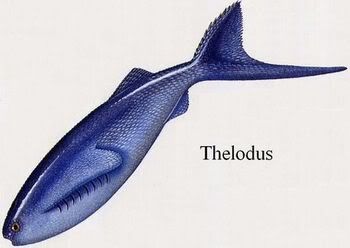

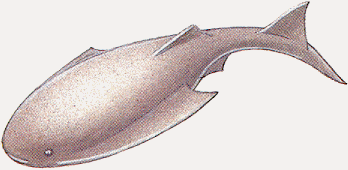




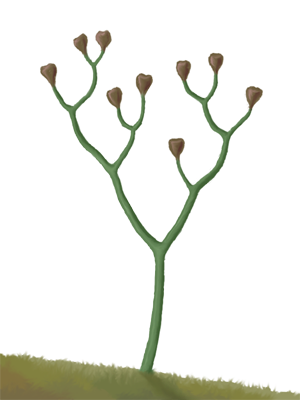



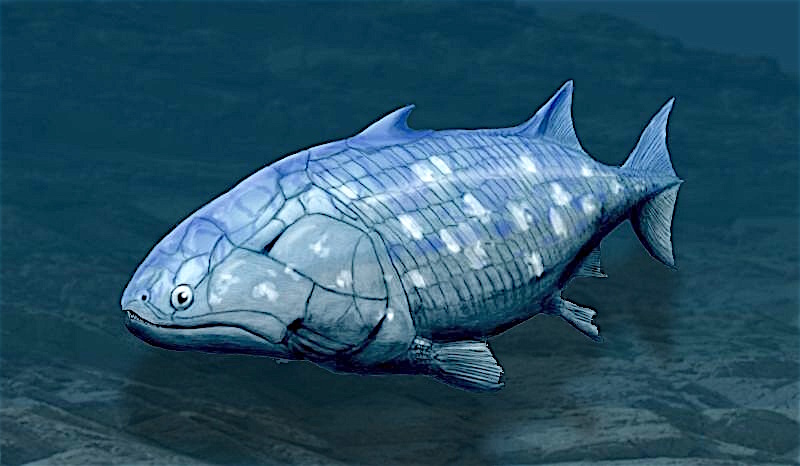
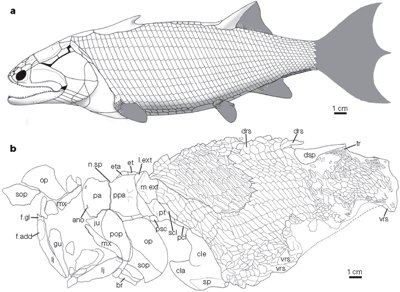


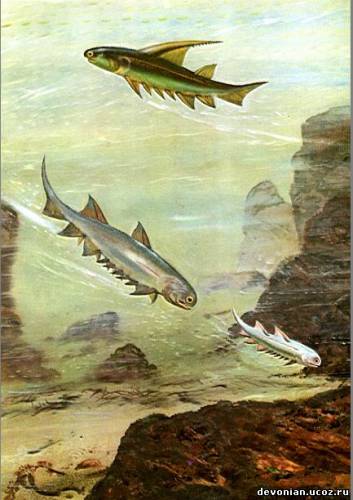












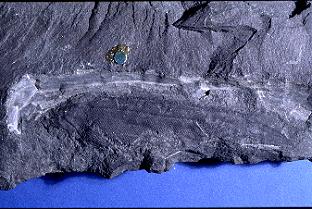












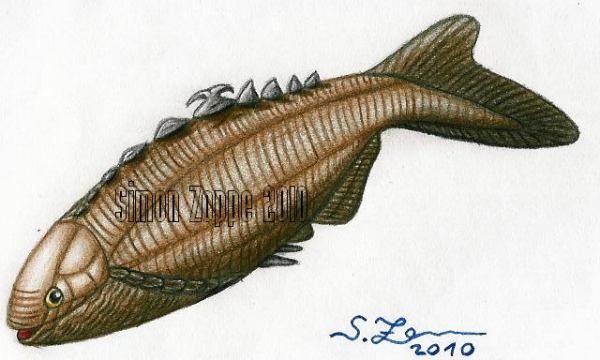





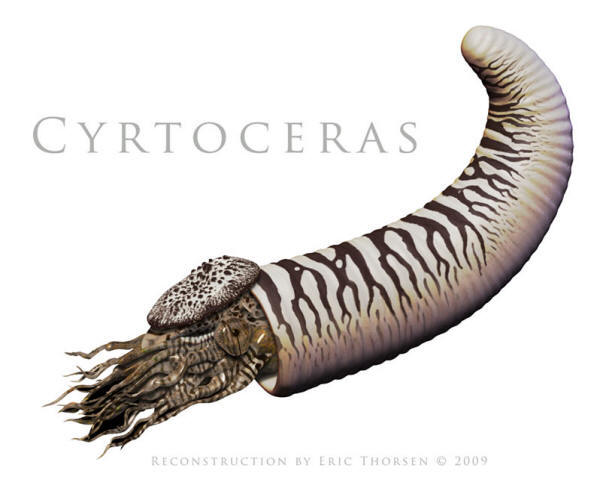




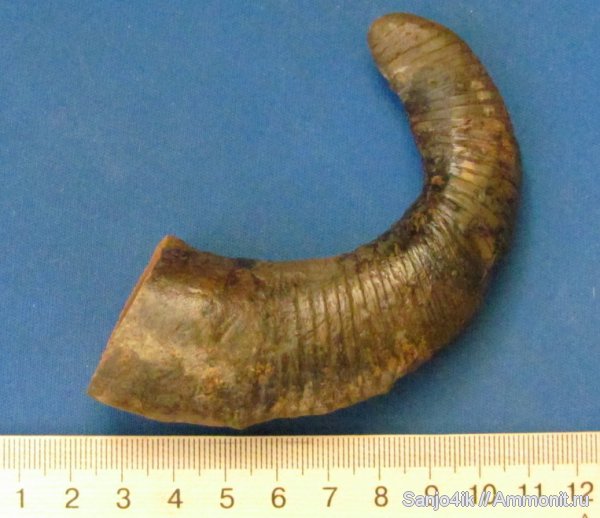






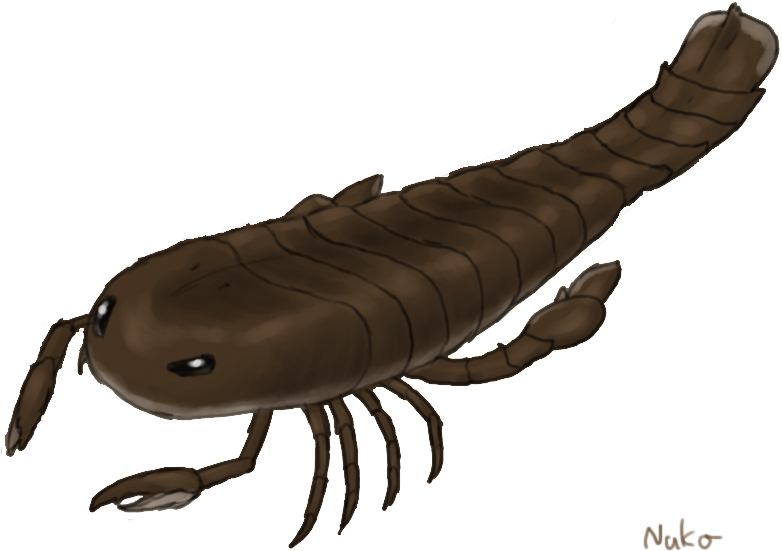

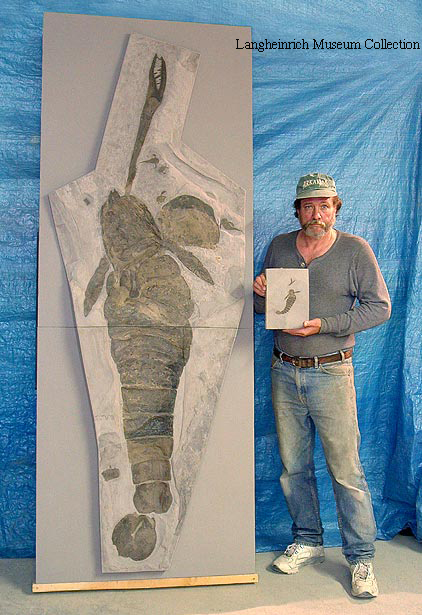
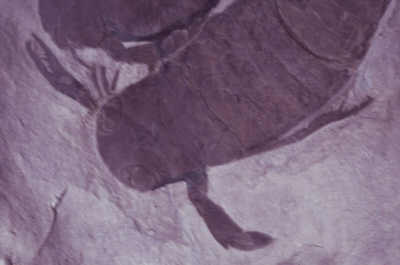



























_buffaloenisis.bmp)
















